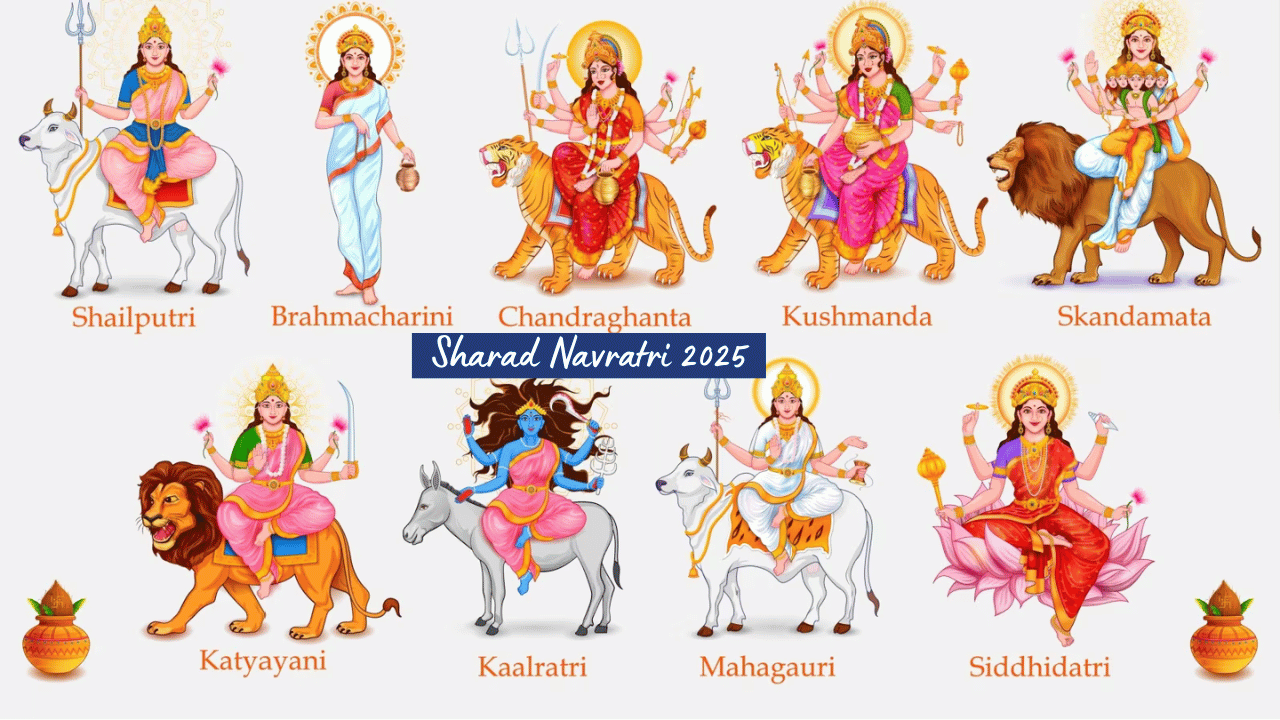Shardiya Navratri (also called Sharad Navratri or Maha Navratri) is one of the most celebrated festivals in the Hindu calendar. It honours Maa Durga in her nine divine forms (Navadurga), symbolizing the victory of good over evil. The festival combines devotion, fasting, cultural festivities, rituals, colours, mantras, and community celebrations. Here’s everything you need to know for 2025.
What is Shardiya Navratri?
- “Shardiya / Sharad” refers to the autumn season (Sharad Ritu) in the Hindu calendar. Navratri means “nine nights.” Shardiya Navratri thus signifies the nine auspicious nights of worship in autumn, dedicated to Goddess Durga and her nine avatars.
- It occurs in the lunar month of Ashwin (bright half, Shukla Paksha). It includes special rituals, fasts, pujas, cultural programs (Garba, Dandiya, etc.), austerity, and spiritual reflection.
Sharad Navratri Date 2025
Calendar for Shardiya Navratri 2025 –
- Start date (Ghatasthapana / Kalash Sthapana): 22 September 2025, Monday
- End of the nine-day puja period (Navami): 30 September 2025, Tuesday
- Vijaya Dashami / Dussehra 2025: 2 October 2025, Thursday marks the culmination (after Navami, following the cultural/festival closure)
There is some nuance: some calendars show Mahā Navami on 1 October and Vijayadashami on 2 October.
Why This Year’s Navratri Is Special
- This year, 2025, there are reports that Navratri is being observed with an “extra tithi” (due to calendar peculiarities) making the cycle a little longer, but the main puja is for the nine principal days.
- The auspicious timings (muhrat) for Ghatasthapana are also highlighted in many sources: e.g. 22 September morning hours (around 6:09-8:06 AM and also 11:49-12:38 PM in some places) have been considered optimal for the start of the ritual.
Day-Wise Goddess Forms, Names, Colours & Significance
One of the most beautiful aspects of Navratri are the nine forms of Goddess Durga worshipped each day, each with its own symbolism and often associated with a specific colour to wear. Day-wise:
Navratri Daily Rituals & Major Puja Events 2025
Beyond deity + colour, each day has rituals, fasting rules, mantras etc. Some major highlights:
- Ghatasthapana (Kalash Sthapana) on the first day: invoking the presence of the Goddess by installing a sacred pot (kalash) with water, leaves, coconut etc. It’s done in an auspicious muhurat.
- Daily puja / aarti / bhajans / mantra recitations for each form of Durga. Many devotees read the Durga Saptashati / Devi Mahatmyam or other sacred texts.
- Fasting / Vrat: Many observe fasts (full or partial), avoid non-satvic food (onion, garlic, etc.), consume fruits, milk, vrat-friendly foods etc. On certain days, stricter days of fast are maintained.
- Sandhi Puja: Important ritual at the junction of Ashtami and Navami (in the evening), especially on 9th day (Navami) during Mahā Navami. Devotional offerings, extra worship etc.
- Kanya Puja / Kumari Puja: On Ashtami or Navami, young girls are worshipped as embodiments of the Goddess.
- Durga Ashtami: Especially important, with many rituals, offerings, cultural significance.
- Vijaya Dashami (Dussehra): The tenth day (or following Navami) marks the victory of good over evil. It is a day of celebration, sometimes idol immersion/visarjan, burning of effigy of Ravana (in regions where Ramayana traditions are followed), or concluding rituals.
Rituals, Mantras & Vrat Rules during Navratri
Some common practices across regions; these may vary by family/tradition / region:
- Wake up early (Brahma Muhurta) to perform puja, bath, dress in chosen day’s colour.
- Setup altar / puja place with picture or idol of the relevant day’s form, flowers, incense, lamp, offerings (fruits, sweets).
- Chanting mantras dedicated to that goddess: e.g. “Om Devi Shailputryai Namah” (for Shailputri), etc. Many use Navarna Mantra, Durga Saptashati etc.
- Offer Prasad / Bhog which can be sattvic. Avoid non-vegetarian items, alcohol, sometimes onion & garlic. Fasting people may have one meal, or two simple meals depending on custom.
- Observing discipline, avoiding negative thoughts, speaking truth, helping others.
Navratri Nine Colours: Meaning & Dress Suggestions
Wearing a specific colour each day is symbolic. Besides devotion, it adds visual unity and joy to festivities. Some thoughts:
- White on Sharad Navratri Day 1: Purity, peaceful start – wearing white kurta, sari, or simple white clothes helps set a calm tone.
- Red on Navratri Day 2: Energy, strength – red sarees/lehenga/or kurta etc.
- Royal Blue on Navratri Day 3: stability and courage.
- Yellow on Navratri Day 4: brightness, joy.
- Green on Navratri Day 5: growth, nature, nurturing spirit of Skandamata.
- Grey on Navratri Day 6: balance, neutrality, seriousness.
- Orange on Navratri Day 7: warmth, enthusiasm.
- Peacock Green on Navratri Day 8: elegance, calm, combination of green & blue vibes.
- Pink on Navratri Day 9: love, compassion, grace, fulfilment.
People often plan their puja attire ahead using these colours. Jewellery, flowers too may match the colour theme of the day.
Significance and Symbolism of Navratri
- Victory of Good over Evil: The mythological story of Goddess Durga slaying Mahishasura etc., is central. Navratri ultimately celebrates that light triumphs over darkness.
- Devotion, Self Discipline: Fasting, early rising, simple living, helping others etc. It’s a time for inward purification.
- Feminine Power (Shakti): Worship of the divine mother in her many forms. Each form embodies different virtues: peaceful, warrior, nurturing etc.
- Community & Culture: Garba/Dandiya (in Gujarat, Maharashtra), processions, communal prayers, cultural programs unify people.
- Renewal / Harvest Time: Occurs soon after monsoon, when crops are harvested; symbolically, nature begins to change in autumn.
Navratri Puja Vidhi: How to Perform the Puja / Ghatasthapana in Narvatri 2025
Here’s a basic guideline; specific customs may vary by region/family/community.
- Clean the puja space, bathe and wear clean clothes (preferably the day’s colour).
- Ghatasthapana / Kalash Sthapana (first day): Fill a pot (Kalash) with clean water, put mango leaves around the rim, place coconut on top, wrap cloth, decorate. This invokes the presence of Durga.
- Mantra recitation and prayers for the day’s goddess. Light diya and incense. Offer flowers, fruits, sweets etc.
- Fasting / Vrat: observe according to your capacity. If doing full fast, take only water or minimal food; many do partial fasts (one meal or two).
- Sandhi Puja (on Ashtami/ Navami transition): perform special rites at the juncture where two tithis meet (often evening).
- Kanya Puja: invite girls (usually nine) representing Navadurga, wash their feet, offer them food and gifts.
- Ayudha Puja / Weapon worship (in some regions): worship tools, instruments – especially if people rely on them.
- Vijaya Dashami: perform final prayers, then celebrate – idols immersion, processions, cultural events, sharing prasad etc.
Sharad Navratri Daily Schedule for Devotees
Here’s a sample daily routine you might follow during Navratri to get both spiritual and practical benefit:
- Wake up early, take bath, wear colour of the day
- Morning puja with mantra and offerings
- Read or recite Durga Saptashati or stotras
- Midday / afternoon rest or work as usual. If fasting strictly, light lunch or fruits etc.
- Evening puja / aarti, maybe community gathering
- Night songs, bhajans, or dance (Garba / Dandiya etc.) where applicable
Sharad Navratri In Different States of India
- In North India, puja, fasts, Kanya Puja, and Ram Lila / Ravan burning on Vijaya Dashami are common.
- In East (West Bengal, Assam, Odisha etc.), the Durga Puja pandals are major, spanning several days; idols are elaborately installed and then immersed.
- In Gujarat / Maharashtra, Garba / Dandiya nights are major, with vibrant dance, song, community gatherings. Colours of each day followed strictly in households/garba groups.
- In South parts, some different rituals or names may be used but overall celebrating the forms, fasting, etc., are common.
How to do Pray in Navratri 2025
- Plan ahead: buy clothes of day-wise colours, arrange puja materials etc.
- Health first: fasting should not compromise health. If you have medical conditions, perhaps do partial fast or consult a physician.
- Keep tithi / muhurat timings as per your local panchang; sometimes puja doors and times differ by location.
- Use sattvic / light foods during these days. Fruits, milk, nuts, and avoid heavy, processed, or overly greasy/stimulating foods.
- Maintain discipline: avoid negative talk/energies, help others, use this time for spiritual growth.
- Rest well: the festival is physically demanding for some.
Navratri 2025 Timings
- Ghatasthapana Muhurats (for setting up Kalash): Many sources mention morning time on 22 Sept 2025 as auspicious (for example between 6:19 AM – 10:19 AM for some locations)
- Durga Ashtami: 30 September 2025, Tuesday. Important rituals on this day.
- Maha Navami: 1 October 2025, Wednesday.
- Vijaya Dashami / Dussehra: 2 October 2025 (Thursday). The final day of the celebrations.
Conclusion
Shardiya Navratri 2025 promises to be a time of deep spiritual renewal, beautiful traditions, vibrant colours, and cultural joy. If you observe it with faith, discipline, and devotion, it can bring calm, positivity, and blessings in life. Whether you are doing full fasts, partial, or simply participating in rituals, the essence lies in sincerity and devotion.
May Goddess Durga’s blessings be with all, bringing strength, health, prosperity, peace, and success. Wishing you and your family a blessed Shardiya Navratri 2025!
FAQs
Q. Is fasting mandatory all nine days of navratri?
A. No. It depends on one’s health, age, capacity. Some fast all nine days, some only first and last days, some partial fasts, etc. Respect your body.
Q. Which goddess is worshipped on which day?
A. Covered above in the Day-Wise Goddess table: Shailputri, Brahmacharini, Chandraghanta, Kushmanda, Skandamata, Katyayani, Kalaratri, Mahagauri, Siddhidatri.
Q. What are good mantras or prayers?
A. Common ones include Navarna Mantra (“Om Aim Hreem KleemChamundaye Vichche”), Durga Saptashati chapters, or simple “Om Devi Durga Namah”, etc.
Q. Can I wear black during navratri?
A. Traditional belief suggests avoiding black during Navratri as it is considered inauspicious; better to choose colours assigned to each day.
Q. What is Sandhi Puja?
A. A special ritual at the juncture of Ashtami and Navami. It is said to be one of the most powerful moments of worship during Navratri.
Q. What is the duration of fast in Navratri 2025?
A. Usually from sunrise to sunset. Some may break fast after evening puja; others may only eat fruits etc.
Q. Are cultural events allowed under the strict fast?
A. Yes, many people combine devotion and festivity – Garba, Dandiya, community events. But ensure rituals aren’t neglected, and maintain spiritual intent.






